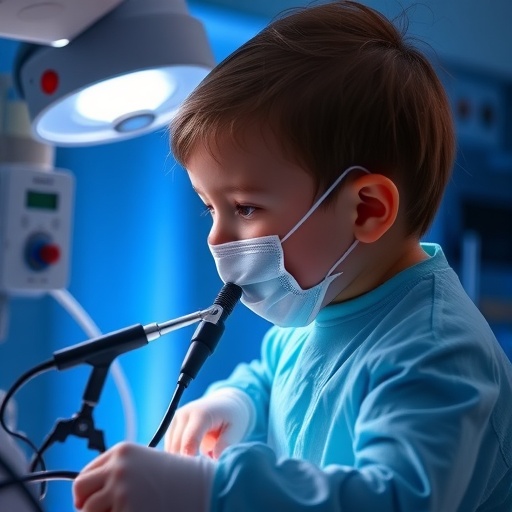In recent years, the field of pediatric bronchoscopy has witnessed revolutionary advancements, transforming both diagnostic and therapeutic approaches for airway diseases in children. A newly published comprehensive review by Li, Tao, Wu, and colleagues, recently appearing in World Journal of Pediatrics, elucidates these transformative changes, focusing extensively on the evolution and current state of pediatric flexible bronchoscopy. This article aims to explore and interpret these breakthroughs, shedding light on the technological and procedural innovations that have refined the practice, enhancing safety, accuracy, and clinical outcomes.
Pediatric flexible bronchoscopy, unlike its rigid counterpart, offers unparalleled access to the intricate and delicate airways of infants and children. Historically, the limitations of early bronchoscopic tools, including inadequate visualization and risks of airway trauma, posed significant constraints. However, with the emergence of ultra-thin, high-definition flexible bronchoscopes, clinicians now access even the most peripheral bronchial segments with remarkable ease. The increased maneuverability mitigates patient discomfort and reduces procedural complications, marking a significant milestone in pediatric respiratory medicine.
Technological innovations extend beyond mere hardware improvements. Integration of advanced imaging techniques such as narrow-band imaging, autofluorescence bronchoscopy, and confocal laser endomicroscopy has enhanced mucosal visualization, permitting real-time assessment of airway pathology at a cellular and subcellular level. These adjunct modalities augment the diagnostic yield of bronchoscopy, enabling early detection of subtle inflammatory changes, neoplasms, and other airway abnormalities that were previously elusive.
Safety remains paramount in pediatric flexible bronchoscopy, given the vulnerability of the patient population. The article accentuates recent developments in sedation and anesthesia protocols tailored specifically for children, minimizing adverse events while ensuring immobility and comfort throughout the procedure. Non-pharmacological techniques such as distraction therapy and child-friendly environments complement these protocols, optimizing patient cooperation and reducing procedural anxiety.
Furthermore, innovations in bronchoscopic accessories have significantly expanded therapeutic capabilities. Specialized micro-instruments permit precise biopsy sampling, targeted drug delivery, and even minimally invasive interventions like airway stenting and foreign body removal. The synergy of flexible scopes with three-dimensional navigation systems enables pinpoint localization of lesions, facilitating personalized treatment strategies and improving prognostic outcomes.
The role of pediatric flexible bronchoscopy in managing congenital airway anomalies has also witnessed profound refinement. Detailed endoscopic morphology visualization guides corrective interventions, often circumventing the need for more invasive surgical procedures. Similarly, in chronic respiratory conditions such as cystic fibrosis and bronchiectasis, bronchoscopy serves as an indispensable tool for both monitoring disease progression and tailoring individualized therapeutic regimens.
The article moreover highlights the burgeoning field of bronchoscopic bioengineering. The advent of biocompatible scaffolds and regenerative medicine approaches, visualized and guided through flexible bronchoscopy, heralds a new era in airway reconstruction. This convergence of technology and biology portends groundbreaking possibilities for treating severe airway stenosis and injury that had previously defied conventional therapies.
In parallel, artificial intelligence (AI) integration into bronchoscopy is emerging as a powerful adjunct. AI algorithms trained on extensive bronchoscopic image databases assist clinicians in real-time anomaly detection, classification, and diagnostic decision-making. This not only enhances diagnostic accuracy but also expedites workflow, reducing procedural times and operator fatigue — critical factors in pediatric settings.
Training and competency development remain essential components when adopting these sophisticated technologies. The review notes novel educational models including high-fidelity virtual reality simulators that replicate the tactile and visual nuances of pediatric flexible bronchoscopy. These simulators provide risk-free environments for practitioners to hone their skills, fostering a new generation of skilled bronchoscopists proficient in both conventional and advanced techniques.
Despite these impressive strides, challenges persist. Access to cutting-edge bronchoscopic technology can be limited by resource constraints, particularly in low- and middle-income regions. The authors call for global collaborative efforts to bridge these gaps, ensuring equitable access and standardization of care. Additionally, ongoing research is crucial to refine sedation protocols further and validate emerging AI tools to guarantee patient safety and optimize clinical benefits.
The future horizon of pediatric flexible bronchoscopy brims with promise. Researchers anticipate the fusion of real-time molecular imaging, robotic bronchoscopy platforms, and nanotechnology to unlock yet unexplored facets of airway pathology and treatment. These innovations challenge conventional paradigms, aspiring to achieve earlier diagnosis, less invasive therapies, and enhanced recovery trajectories for pediatric patients worldwide.
In conclusion, the article by Li et al. offers a panoramic view of advances in pediatric flexible bronchoscopy, underscoring its pivotal role in contemporary respiratory medicine. The integration of cutting-edge optics, imaging adjuncts, AI, and procedural refinements converges to form a powerful, minimally invasive toolset that continues to evolve. As these technological and clinical improvements disseminate globally, the prospects for improved care and outcomes in pediatric airway diseases have never been brighter.
Physicians, researchers, and healthcare stakeholders alike are poised on the cusp of a new era, where pediatric flexible bronchoscopy transcends traditional boundaries, fostering innovations that promise to transform children’s respiratory health worldwide. The comprehensive insights presented in this review illuminate a pathway toward safer, more precise, and increasingly effective bronchoscopic care, ultimately redefining standards and expectations in pediatric pulmonology.
Subject of Research: Advances and innovations in pediatric flexible bronchoscopy technology, techniques, and clinical applications.
Article Title: Advances in pediatric flexible bronchoscopy.
Article References:
Li, SX., Tao, XF., Wu, HJ. et al. Advances in pediatric flexible bronchoscopy. World J Pediatr (2025). https://doi.org/10.1007/s12519-025-00967-7
Image Credits: AI Generated
DOI: https://doi.org/10.1007/s12519-025-00967-7
Tags: airway diseases in childrenairway trauma reduction techniquesdiagnostic and therapeutic bronchoscopy in childrenhigh-definition flexible bronchoscopesimaging techniques in bronchoscopymucosal visualization in bronchoscopypediatric bronchoscopy safety enhancementspediatric flexible bronchoscopy advancementspediatric respiratory medicine breakthroughsprocedural complications in pediatric bronchoscopyreal-time airway pathology assessmenttechnological innovations in bronchoscopy





